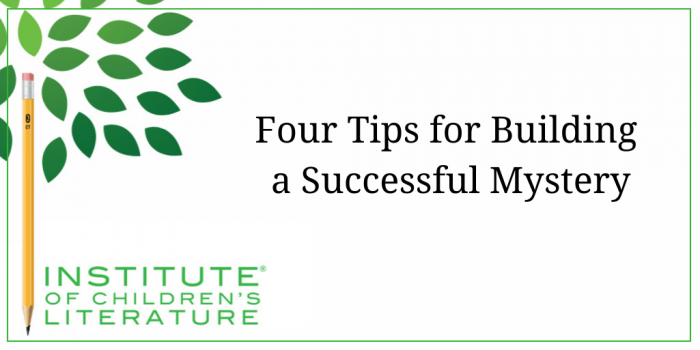1000 N. West Street #1200, Wilmington, DE 19801
© 2024 Direct Learning Systems, Inc. All rights reserved.

At this point, I have sold well over two dozen mystery novels for adults and have written and sold mysteries for children, both as short stories and chapter books. In fact, many of my adventure stories have a strong mystery structure along with the adventure. This is because:
• 
• A good puzzle has a clear question and a “right” answer that requires careful thought.
• Good puzzles are challenging but not frustrating.
• Good puzzles are fun.
But your first mystery story can feel overwhelming to plan and write so here is how I do it, using a method I’ve honed through all these published books and stories.
I begin with a question because this serves as the foundation for the puzzle part of the book. For my adult mysteries, the question is often “who killed this guy?” but even within that, there are a lot of sub-questions about why and how. For kid mysteries, the question is often more gentle as most mysteries for children do not involve dead bodies (unless the character is finding bones that have been around for a hundred years or so). So the question can be very serious, even potentially life-threatening like “Where is my dad?” or more of an intellectual puzzle like “Who stole the mummy’s jewel?”
To build a good mystery I need an age-appropriate question. And I need to surround it with interesting elements. Something like “Who stole the mummy’s jewel?” tends to suggest possible interest right in the question. Kids love mummies. Plus, mummies tend to hang out in potentially interesting (and possibly creepy) places like museums or tombs. I need a question that is inherently interesting and compelling. I’ll also need a question that’s capable of being attached to my main character. If my main character is an ordinary third grader, a question like “Who kidnapped the president?” is going to be tough to tie to my main character unless I’m going to turn my character into the president’s daughter or the president’s daughter’s best friend. It probably wouldn’t be enough to simply have the main character be a kid visiting Washington, D.C. on a school field trip, because it would simply be too difficult for an ordinary child to get involved with the president’s kidnapping. It could be done (in fact, as I type this I can think of some ways) but I’m only going to ask questions if I can see a believable way to link the question to my main character.
If I just begin writing a mystery when I don’t know the answer, I may end up with a publishable mystery (mostly because I’ve written so many of them) and I may end up with a big mushy pile of confusing doo (and we’re not talking Scooby Doo). So before I start writing, I brainstorm several possible solutions. Imagine I’m trying to write “Who stole the mummy’s jewel?” I might consider one answer to be “What if the crook actually stole the whole mummy and replaced it with a forgery, but the jewel was the only part the crook couldn’t forge? And what if the crook actually just slipped the real mummy into a false compartment in the mummy’s display?” If I like that answer, I can see that whoever built the display is the logical bad guy in that possible ending. That becomes my first possible answer.

As I keep thinking, I might come up with even more options. For instance, I love the idea of the lights going out. Anything can happen in the dark. What if the thief were the grumpy museum guard who ran into my main character when the lights were off and knocked her down? And maybe the jewel was that suspicious lump my character saw in the guard’s coat pocket! I might do this brainstorming for a while, coming up with lots of possible answers to my question. Why do I need more than one answer? Because the road to solving a mystery is never straight and I’m going to need to make several solutions look plausible as I move my little story detective toward the real answer. If I don’t have several solid, interesting answers, my reader is going to figure out the story too quickly and it’s not going to be interesting. A mystery that’s too simple gets labeled with the most dreaded word in kidlit: “stupid.” No one wants kids thinking their story is stupid.
When I look at the ideas I’ve brainstormed, I might like the guard and the little old lady. The mini-detective might think the culprit is the guard since he had the lumpy pockets and the bad attitude, but I’m also going to sprinkle in some very subtle clues about the little old lady as well. She might be rather chatty before the crime, for instance, but not say a word afterward. And she could have a very solicitous niece who keeps the police from badgering her clearly overwrought elderly aunt.

At this point, I want my reader to be as lost as my main character even though most of the clues will already be on the table, so I’ll need some clues that make the old lady seem weird and some that make the tourist’s “camera” seem shady. I’ll then move the character to examine both of the other answers. The one that isn’t right will be slightly more impressive than the right choice.
A good mystery becomes clear and solves only when the main character employs a new way of looking at the problem or discovers his own pre-existing weaknesses that have been pushing him in the wrong direction. For instance, in a long work (like a middle grade novel) I might have a side plot working along with the mystery that involves the main character adapting to his grandfather moving in with them. The main character may have had some pre-existing notions about old people that are turned on their head by his feisty grandfather who is physically weak but mentally sharp. And when my main character realizes how much he has always thought of old people as helpless, he realizes that kept him from really wondering about the old lady’s odd actions. And that brings us to the “solution.”
For most mysteries, solutions come by some kind of change–a change in how we look at the problem, or a change in the main character’s beliefs. This turning point and this side plot will elevate the whole story above being a straightforward puzzle and make it something lingering and lasting.
So now you know my secrets. What puzzles will you crack with them?
With over 100 books in publication, Jan Fields writes both chapter books for children and mystery novels for adults. She’s also known for a variety of experiences teaching writing, from one session SCBWI events to lengthier Highlights Foundation workshops to these blog posts for the Institute of Children’s Literature. As a former ICL instructor, Jan enjoys equipping writers for success in whatever way she can.
1000 N. West Street #1200, Wilmington, DE 19801
© 2024 Direct Learning Systems, Inc. All rights reserved.
1000 N. West Street #1200, Wilmington, DE 19801
© 2024 Direct Learning Systems, Inc. All rights reserved.
1000 N. West Street #1200, Wilmington, DE 19801
© 2024 Direct Learning Systems, Inc. All rights reserved.
1000 N. West Street #1200, Wilmington, DE 19801
© 2024 Direct Learning Systems, Inc. All rights reserved.

1000 N. West Street #1200, Wilmington, DE 19801
© 2025 Direct Learning Systems, Inc. All rights reserved.

1000 N. West Street #1200, Wilmington, DE 19801
©2025 Direct Learning Systems, Inc. All rights reserved. Privacy Policy.
2 Comments